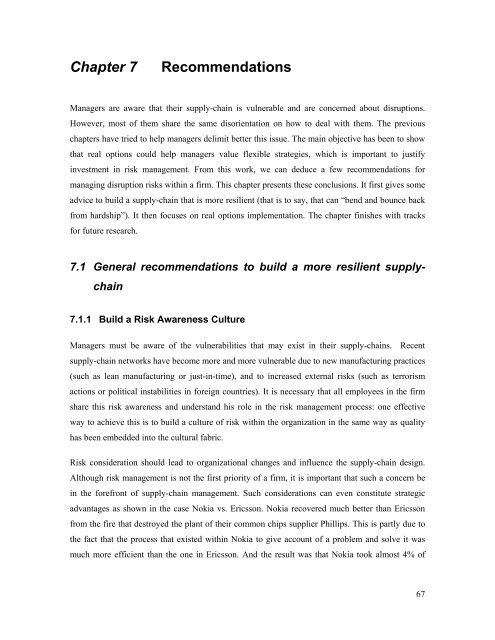Managing Risks of Supply-Chain Disruptions: Dual ... - CiteSeerX
Managing Risks of Supply-Chain Disruptions: Dual ... - CiteSeerX
Managing Risks of Supply-Chain Disruptions: Dual ... - CiteSeerX
You also want an ePaper? Increase the reach of your titles
YUMPU automatically turns print PDFs into web optimized ePapers that Google loves.
Chapter 7RecommendationsManagers are aware that their supply-chain is vulnerable and are concerned about disruptions.However, most <strong>of</strong> them share the same disorientation on how to deal with them. The previouschapters have tried to help managers delimit better this issue. The main objective has been to showthat real options could help managers value flexible strategies, which is important to justifyinvestment in risk management. From this work, we can deduce a few recommendations formanaging disruption risks within a firm. This chapter presents these conclusions. It first gives someadvice to build a supply-chain that is more resilient (that is to say, that can “bend and bounce backfrom hardship”). It then focuses on real options implementation. The chapter finishes with tracksfor future research.7.1 General recommendations to build a more resilient supplychain7.1.1 Build a Risk Awareness CultureManagers must be aware <strong>of</strong> the vulnerabilities that may exist in their supply-chains. Recentsupply-chain networks have become more and more vulnerable due to new manufacturing practices(such as lean manufacturing or just-in-time), and to increased external risks (such as terrorismactions or political instabilities in foreign countries). It is necessary that all employees in the firmshare this risk awareness and understand his role in the risk management process: one effectiveway to achieve this is to build a culture <strong>of</strong> risk within the organization in the same way as qualityhas been embedded into the cultural fabric.Risk consideration should lead to organizational changes and influence the supply-chain design.Although risk management is not the first priority <strong>of</strong> a firm, it is important that such a concern bein the forefront <strong>of</strong> supply-chain management. Such considerations can even constitute strategicadvantages as shown in the case Nokia vs. Ericsson. Nokia recovered much better than Ericssonfrom the fire that destroyed the plant <strong>of</strong> their common chips supplier Phillips. This is partly due tothe fact that the process that existed within Nokia to give account <strong>of</strong> a problem and solve it wasmuch more efficient than the one in Ericsson. And the result was that Nokia took almost 4% <strong>of</strong>67
















